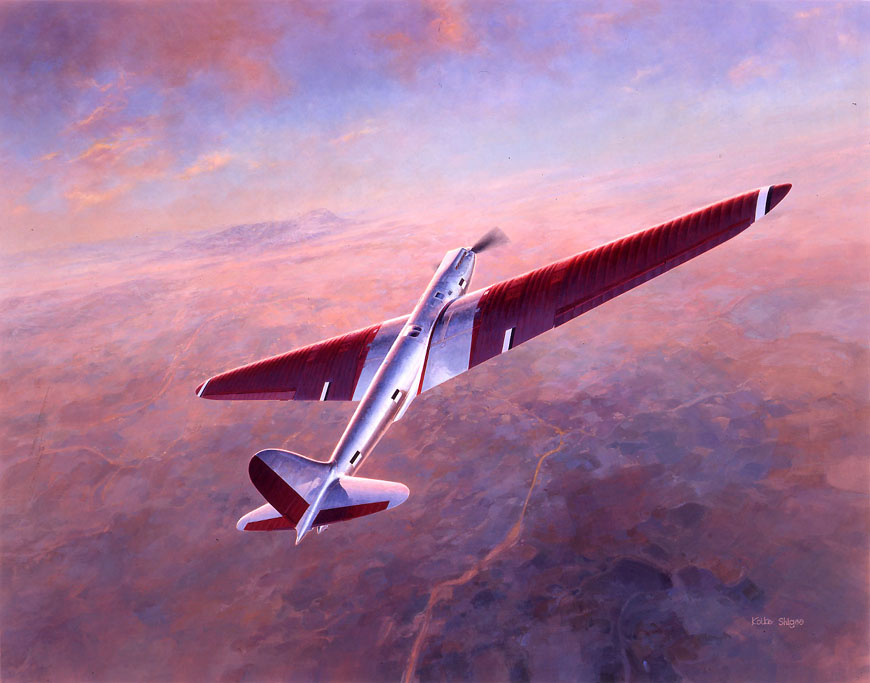|
The Tokyo Empire University Aviation Laboratory was established
in 1918 as one of the laboratories attached to Tokyo University.
The laboratory was started on a small scale: at the time the
aviation laboratory was established, there were only two or three
aircraft specialists working in the laboratory.
Calamity then ensued, when the laboratory building collapsed
during the Great Kanto earthquake of 1923; it was rebuilt on
the University's Komaba campus in Meguro-ku (one of Tokyo's special
wards). Early research efforts proved difficult and a lack of
progress resulted in several different plans and activities pilling
up, without significant accomplishments.
At the beginning of the Shohwa era (corresponding to the reign
of Emperor Sh?wa (Hirohito), from December 25, 1926 to January
7, 1989), the head of the aviation laboratory, Chuzaburou Jinba,
decided to publisize the work of the laboratory to the general
public. In order to do this, he decided to develop an airplane
which could establish a long distance flight record. In addition
to generating publicity for the laboratory, this effort would
increase staff confidence in their research efforts.
During this time, long distance flight was very much in the mind
of the aviation world, with many attempts as long distance flight
being made. There was much talk about using winds originating
in the West and blowing East (called a West wind) to make a transpacific
flight.
An example of this type of effort was the famous 1931 transpacific
flight of Clyde Pangborn and Hugh Herndon, Jr., for which they
won a prize of $25,000 from the Japanese. This flight set a transpacific
record 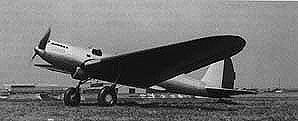 of 4,500 nonstop miles in 41
hours and 13 minutes, and helped increase a Japanese-American
cultural connections (reference: the (American) National Aviation
Hall of Fame web site). of 4,500 nonstop miles in 41
hours and 13 minutes, and helped increase a Japanese-American
cultural connections (reference: the (American) National Aviation
Hall of Fame web site).
In this spirit, a "Plan for the Opportunity for Long-distance
Flight Design and Production" was submitted in 1931 to the
Ministry of Education by Chuzaburo Jinba of the Tokyo Empire
University Aviation Laboratory.
A large budget of 250,000 yen was allocated for this project,
and work was begun on this effort. Professor Suhara took charge
of the overall program, with Professor Iwamoto directing the
staff who would then design the motor and the plane's body and
components. Hidemasa Kimura took charge of the body shape, wings,
and tail construction. Ichiro Tani took charge of air dynamics.
Keikichi Tanaka took charge of the motor. Kiyoshi Tomitsuka took
charge of cooling and exhaust. Ichiro Watanabe took charge of
the vaporization vessel. Yuzaburo Nagai took charge of fuel.
Ryouzo Fukatsu took charge of the avionics power design. Sanji
Kawada took charge of the propeller. Tatsuji Sasaki took charge
of control and operating systems. Katsumoto Atsugi took charge
of paints.
During this time, the world distance flight record continued
to be broken and advanced by various groups in the world, and
aviation technology was undergoing rapid change.
Although the proce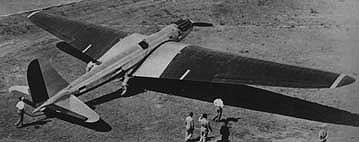 ss of designing
the airplane went smoothly, a problem developed as to where to
produce the body (airframe) and motor. The demand for production
of airplanes by the Japanese military was very great during this
time, and some airplane production companies could not keep up.
Moreover, the total cost of production was projected to be over
the given budget of 250, 000 yen. ss of designing
the airplane went smoothly, a problem developed as to where to
produce the body (airframe) and motor. The demand for production
of airplanes by the Japanese military was very great during this
time, and some airplane production companies could not keep up.
Moreover, the total cost of production was projected to be over
the given budget of 250, 000 yen.
To help solve these difficulties, Goro Matsukata, of Tokyo Gas
and Electric Industry Co., Ltd. offered to help the project.
However, the Tokyo Gas and Electric Industry Company only had
experience in the production of light wooden airplanes, and with
only twenty-five persons available for production, building this
new plane, with all new technology, seemed impossible.
But the team went on and perfected a general design plan for
the plane in the design room of Tokyo Gas and Electric Industry
Co., Ltd. But progress was difficult, because of the limited
numbers of persons and the new technology.
The design team then worked detailed designs from the general
design plan, first detailing the plane's body and main wing form,
and then working out the tail wing and tail, using models in
wind tunnel experiments.
But the selection of a suitable motor presented a big problem.
Initially, a diesel engine was planned in order to meet the specifications
for a long flight. But, it was difficult to develop a reliable
engine in a short time. So, the team decided to use an improved
BMW / liquid cooled / V12 cylinders / 715 horsepower engine manufactured
by Kawasaki for the long-distance flight. A Sumitomo SW-4 wooden
two-blade propeller (with a diameter of 4.00m) was adopted for
this engine.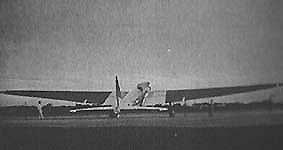
By 1935 the project reached the manufacturing stage, and began
using the actual materials for the plan. The goals were known:
the lift/drag-ratio needed to be made large, and propeller efficiency
needed to be improved, in order to achieve longer flight distance.
Then, the fuel consumption rate of the motor needed to be reduced
while maximizing the amount of fuel carried. But much time was
wasted due to inexperience in metal processing, while the maintenance
of tools was also a recurring problem.
The plane was nevertheless beginning to take form: a large aspect
value of nine was achieved to improve the lift/drag ratio. The
main wing table skin was made using Egyptian cotton of the best
quality. Coats of paint were applied no less than 11 times, and
the main wing was polished up like a mirror. Air resistance was
greatly reduced as a result.
The color of the wing was made a striking crimson, which gave
people the idea to call the plane the "Crimson Wing".
The superior flight characteristics generated by these design
features demonstrated themselves during emergency landings. The
landing gear was made a completely retractable. The landing gear
was folded up inside the plane and the opening completely closed.
Special smoothing was used for the outside board body tack (flat
head rivets) at the plane's first trial. Only during takeoff
and landing was a windshield raised above the cockpit. During
other times, the windshield was folded down, and put away into
the body, in order to reduce drag. However, flight control with
the windshield down was very difficult due to poor visibility.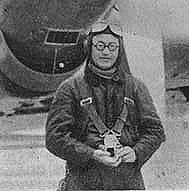
As the plane approached completion, a crew was appointed:
Major Yuzoh Fujita, from the Army Aviation Technology Laboratory,
was made pilot, Fukujiro Takahashi co-pilot, and Kinkichi Sekine
engineer.
The first airplane was completed on March 31, 1937. It made its
first flight at Haneda Airport (formerly known as Tokyo International
Airport) on May 25. After that, test flights were conducted for
half a year. However, its first attempt at breaking a distance
record on November 13th ended in failure due to a landing gear
problem. The second attempt at a world record, on May 10, 1938,
was also abandoned, due to failure of the automatic pilot. So,
the team looked towards the next attempt on May 13th. . . Friday
the 13th!
After some last minute repairs, the plane took off. The time
was 4:55 a.m. - early morning. Takeoff was against a wind of
1.4m/sec. The runway at Kisarazu 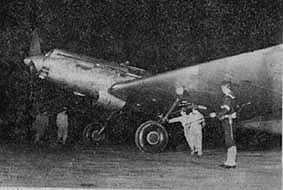 airport
was 1,200m long. The total weight of the airplane at takeoff
was 9,216 kg, and the fuel tanks contained no less than 5,822
L. With 40m of runway to spare the KOUKEN-KI was aloft, its Crimson
Wing lifting it through the air. airport
was 1,200m long. The total weight of the airplane at takeoff
was 9,216 kg, and the fuel tanks contained no less than 5,822
L. With 40m of runway to spare the KOUKEN-KI was aloft, its Crimson
Wing lifting it through the air.
A course was set through the old naval airport at Kisarazu, with
the main building of Nakajima Airplane Company in Oota city,
Gunma Prefecture, off against the sky to the left, it flew past
Choshi in Chiba Prefecture. It then banked and turned at the
Aviation Lighthouse on the seashore at Hiratsuka in Kanagawa
Prefecture, traveled 401.759 Km, and then banked and turned back
towards the Kisarazu airport, making a three-corner course.
In the world of aviation, the excitement welling up inside the
chests of the technicians who were watching the takeoff and flight,
and their deep emotions and sense of pride, must be an experience
unique to the pioneers of early flight!
The airplane then went on to fly for 29 laps around this circuit,
and, with the weather deteriorating and several minor mechanical
problems, including a broken exhaust valve cooling ventilator,
on May 15, 1938 at 7:20 p.m., Major Fujita brought his plane
down for a landing.
A new world record for total flight distance 11,651.011 km was
established during this flight. A speed record of 186.192 km/h
over 10,000 km was also officially agreed to by the Federation
Aeronautique Internationale (World air sports federation or FAI)
as a world record.
And, when it landed, there was 500 L of fuel left, which meant
the plane could have flown an additional 1,200 Km.
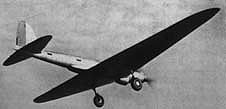 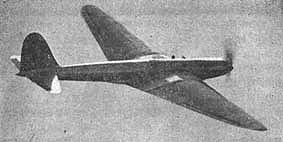
The establishment of this new world record proved that Japanese
aviation had matured to world-class status, but the plane seemed
to some only useful to challenge the world record. Professor
Hidemasa Kimura decided he wanted to do more: he wanted a plane
to fly with passengers non-stop from Tokyo to New York City.
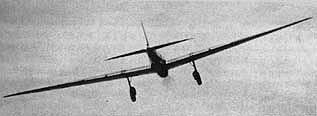
A plan to produce a plane for this long distance flight was created
to commemorate the year 2600 (counted based on the traditional
founding of the Japanese Nation in 660 BC by Emperor Jimmu) with
the help of funding by the Asahi Shimbun Publishing Co. This
plan was announced officially in 1940, and a technology advisory
committee was organized. Hidemasa Kimura became one of the main
architects of this effort, and set about developing the design
foundations for this new plane.
A plane with twin engines designated the A-26 was built for this
effort. The main body of this plane was made by Tachikawa Airplane.
The engine was adopted from a model SAKAE (HA-115) of a Nakajima
airplane. The landing gear was made at an Okamoro factory, and
the propeller was manufactured by Sumitomo Metal.
The A-26 was excellent design overall: the width was 29.43m,
overall length was 15.30m, gross weight was 16,725 kg. Sadly,
the outbreak of wider conflict in the Pacific in 1941 precluded
Professor Hidemasa Kimura's dream of a Tokyo to New York flight.
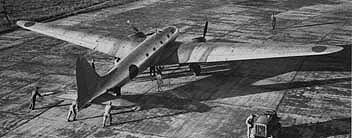
Using one of the A-26 planes, which had been completed in 1942,
a flight from Singapore to Berlin was attempted in 1943. But,
after it took off Singapore, it was lost; presumed shot down
or otherwise lost at sea, over the Indian Ocean.
One more record making flight was attempted with the A-26
on July 2, 1944, flying laps around the three-leg route Shinkyou
to Hakujoushi to Harupin in Northern China. This flight traveled
16,435 km. This set a world record, but was not recognized as
such, due to the fact that this wartime flight had not been authorized.
And while Japan's pilots were locked in mortal combat with American
and allied pilots over the vast Pacific, the distance between
Tokyo and New York City via San Francisco was a mere 12,403 kilometers.
- A flight even attainable
with the Crimson Wing,
beauty forged by engineers,
who dreamed of peaceful flight,
flying on the West winds,
toward the rising sun,
reaching out for America. . .
-
- -----------------------------------------------------------------------------------------
- The movie of Long-range challenging
flight (by "You Tube") : Part1, Part2, Prat3
|
"KOKEN-KI "
"KOKEN-KI "
